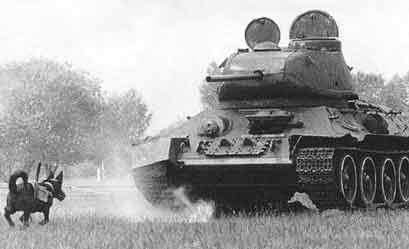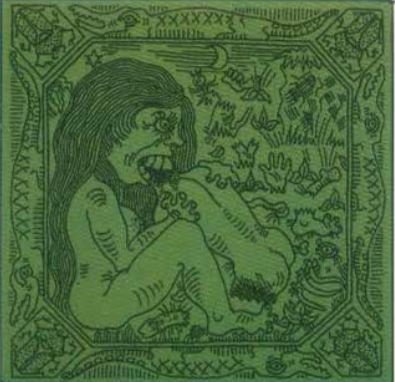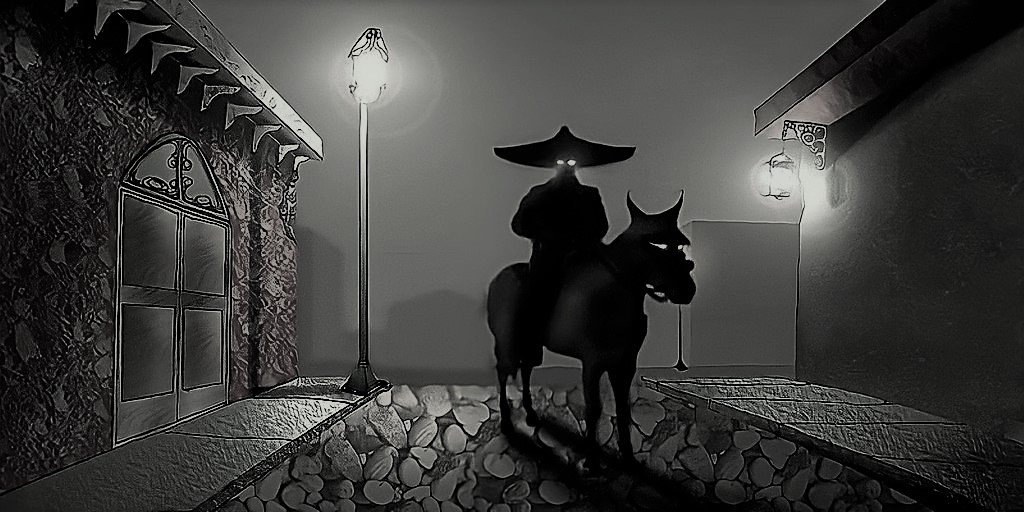The Russian Anti-Tank Dogs of World War II
Between 1920 and 1940 The Soviet Union’s Red Army developed dog training facilities in order to use dogs to help deliver messages, supplies, and pull injured soldiers on sleds off the battlefield.
The program was a success and when soldiers came up against a tank during World War II someone must have looked over at a dog, happily panting away, and gotten a horrible, horrible, idea.
“This is definitely not a good idea.”
The Problem and Plan
To be fair the original idea wasn’t that bad. Dogs, specifically German Shepards, would carry explosives on its back, run under a tank, and then pull a belt on their vest that dropped the bomb. The dogs could then safely run back to the trainer/soldier before the bomb went off. It was a win-win except for the Nazi’s tanks… but that still counts as a win in my book.
Related Article: The Bat Bombs of World War II
You’re probably asking, why even use dogs in the first place, can’t they use landmines? And if you’re not asking it, hopefully you are now, otherwise, you won’t care for the next few paragraphs. Yes, the Red Army could use mines and they often did but they were unreliable. Take a look at this picture of a tank I’m borrowing from Wikipedia:
Obviously, tanks during World War II didn’t look exactly like this but, one thing they did have in common with modern-day tanks was the Road wheel, Track, and Links. If you want to stop a tank in its tracks you have to destroy one of these and a mine was effective at doing this, but notice that the tracks are somewhat narrow relative to the tank.
This means that a tank driver could maneuver around a landmine or if the mines were buried, there was a good chance they would never hit it. Sure, you could bury a horizontal line of mines next to each to ensure one is hit by the tank, but once the tank hits one mine, the force of that blast will cause the one next to explode which causes the next one, etc.
You’d have wasted a line of mines to take down one tank and here’s a news flash, armies tend to have more than one tank. The best way to stop a bunch of them was to figure out a way to deliver several pounds of explosives directly to them, and dogs just happen to be fast and agile. Also, give them enough snacks and they’ll do anything without question.
“SOMEONE SAY SNACKS?!”
So in the late 1930s training began on crafting these intelligent, loyal, and happy dogs into the war dogs known as the Anti-tank dogs.
Related Article: Operation Vegetarian: The British Anthrax Plan of WWII
A New Problem
The training lasted only six months and that’s not a good thing. See, it turns out the dogs weren’t able to pull on that belt to release the bombs, they failed every test.
Now I couldn’t find any information on why they weren’t able to, could be the force needed to release the explosives was more than the dog could pull, or the belt wasn’t properly manufactured, or maybe the dogs took too long to release the bomb, but dogs are the best so I’m not going to blame them.
Because of this the program was scrapped and seen as a failure… oh wait no, The Red Army decided that if the dogs couldn’t drop off the bombs, then the dogs would be the bombs.
“Hold the fuck up.”
Instead of a vest designed to drop off explosives, the dogs were fitted with two canvas pouches carrying a total of around 25 pounds (around 12 kg) of explosives. A wooden lever was then attached to the explosives in the pouch and stuck out in such a way that when the dog dove under the tank, it would trigger the bombs.
This change was approved and now all that needed to happen was training the dogs to willfully dive under tanks in between their tracks. The trainers did this by first starving the dogs and then placing food under tanks that were turned off.
When the dogs became accustomed to going under tanks, the same procedure was done again, this time the tank’s engines were on. Once the dogs grew comfortable with the sound of tank engines, the same thing was done with the army playing sounds of guns going off and bombs exploding.
By the end of training in the Summer of 1941, the dogs were ready to be unknowingly sacrificed on a battlefield.
Related Article: Unsinkable Sam: The World War II Cat
Dogs of War
One of the first dog infantries had 30 dogs with 40 trainers and when they came upon some German tanks… it was a disaster. The infantry released 20 of the dogs with bombs and none of them were able to destroy a single tank.
One of the problems was that the dogs weren’t trained with moving tanks, all their training dealt with stationary tanks so the dogs weren’t used to jumping under a moving one. Another issue was the dogs were accustomed to the sounds of war but not when the sounds were coming from the tanks themselves.
Additionally, the dogs weren’t used to the tanks trying to kill them with bullets. Many dogs were too scared to continue and ran off. Finally, the biggest (and most embarrassing) was that the dogs had been trained with Soviet Union tanks that used diesel fuel, while German tanks used gasoline.
Dogs have a pretty good sense of smell so if they’re used to jumping under a big thing that smells like diesel, they’re going to search those out… and they did. Within moments some dogs were attempting to run under Soviet Union tanks instead of German tanks. Several Red Army soldiers were forced to kill the same dogs they had trained.
I know what you just read so here’s a happy dog
A letter from a Red Army captain dated October 16th, 1941 detailed his own struggles with his set of dog bombs. In his letter, he wrote most of the dogs refused to go out into the battlefield and ended up jumping back into the trenches causing injuries to the infantry.
The Nazis caught on to the plan and killed three of the dogs before the bombs could go off. Five dogs had to be killed by the trainers as they were trying to run back to the trenches. Four dogs exploded near tanks but there was no confirmation that the tanks were incapacitated.
“FOUR DOGS EXPLO- aww look at the happy dogs!”
A Failure
After these two incidents and presumably many others, the program was seen as a failure. Though at the end of the war the Soviet Union claimed the program was a success and said the anti-tank dogs destroyed over 300 Nazi tanks. This was seen as propaganda since no one was allowed to say anything negative about the war efforts.
I couldn’t find any documents anywhere showing that the program actually was a success and when other countries like the U.S. tried to implement the same program, it was shut down because it doesn’t work. Luckily for the dogs in those countries, it didn’t get past the training stage.
Any articles I did find that stated the program was a success in Russia had no sources. Articles with sources stated anti-tank dogs were no longer used by 1942. Dogs did remain extremely helpful in the war effort but, luckily, it was to help deliver supplies that didn’t end with a big explosion.
Related Article: Cher Ami: The Hero Pigeon of World War I
Quick Facts
Because there weren’t any dedicated dog trainers at the time when the program started, The Red Army used teachers and circus trainers to train the dogs
While most anti-tank dog missions were a failure, one reportedly did result in 12 destroyed tanks

















